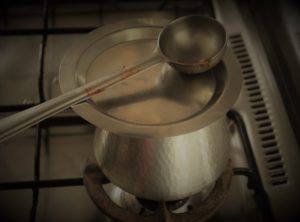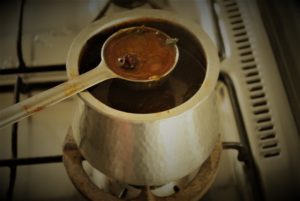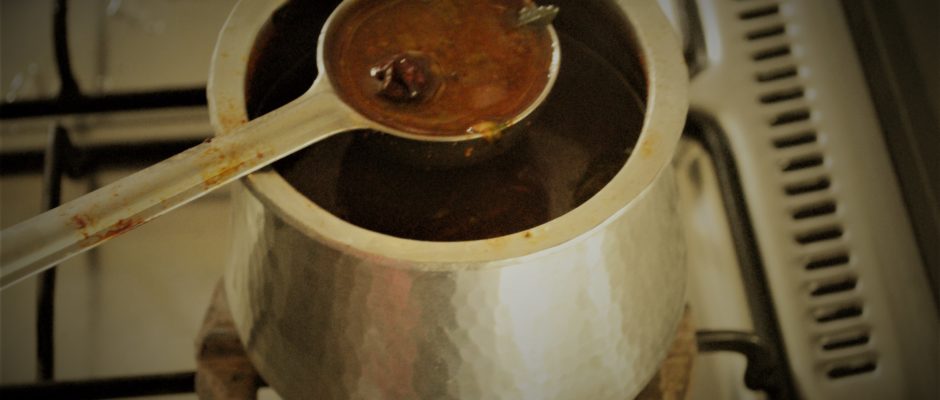Simplicity Coimbatore ,Eeyam chombu for your rasam

The article on natural perungayam that was published a few weeks ago garnered a great deal of interest.A friend from Bangalore sourced the pure perungayam from the store here in Coimbatore. Upon receiving the package,the air in the room began to carry the distinctive aroma of this unique spice(even before opening the sealed cover!)
A week later she texted saying that the difference in flavour of the asafoetida was remarkable and she loved the taste of it in her “eeya chombu rasam”. It had been so long since I had heard anyone mention the ‘eeyam chombu’. Throughout that day ,all I could think about was of this unique vessel which was once considered a precious possession in many of the kitchens in Tamil Nadu .
While the word eeyam may mean lead or even be used to refer to aluminium, there is no lead or aluminium in this sombu! The eeyam chombu /sombu is made of an alloy of tin and other metals. It does not contain any lead. In fact the actual vernacular name for lead is “Karu eeyam” and this tin coating is called “Velli eeyam”. Over time the word eeyam came to be confused with people not knowing if it was lead or any other metal. “Eeyam poosaradhu” is a term that we are all familiar with.Back in the day , when brass, copper, silver utensils were used for cooking,the inside would be coated with velli eeyam. This alloy of metals was said to have beneficial properties when used to cook traditional dishes ,mainly rasam. The combination of several ingredients like tamarind, asafoetida, tomato, dhal, garlic, onion, turmeric, black pepper, fresh herbs like curry leaves, coriander and ghee cooked in an eeyam sombu apparently did more than just elevate the taste of this aromatic broth.It also imparted sufficient quantities of the minerals and metals required for a healthy working body.

When knowledge is shared on a global platform we often fail to look at the positives which are to do with a native lifestyle. Well meaning articles from experts in the field about the ‘musts’ and ‘must-nots ‘ about cooking utensils did find it’s way into the educated minds of most homes.The eeyam chombu was relegated to it’s corner or sold. In it’s place came shiny stainless steel vessels,requiring little maintenance other than a good scrub. Copper and brass vessels were set aside ,forgotten and allowed to develop the telltale green patina (a reaction when in constant contact with the atmosphere).Mud pots and the special kal chatti were also given respite from the arduous task of being subjected to daily cooking.
What we forgot was that these vessels were not just of utility value but imparted much needed health benefits which provided the right balance of essential nutrients for daily living. Thankfully a lot of us are now curious about the reasons behind many of the age old practices. Often we discover that ‘patti did know best’. Eating local ingredients in traditional recipes is something that will boost health better than any diet.It is not just a fad but a sustainable way to live and this thought process is gaining momentum across the world.
Literally after spending a whole day thinking about the eeyam chombu and remembering a conversation which I had many years ago with my grandmother and her Brahmin lady friend,I was delighted to find a well made eeyam chombhu at the local pathram kadai (metal utensil store) Kumbakonam is famous for making the best eeyam sombu.It is manually a laborious process and takes anywhere from 10-12 hours to make one sombu.
Cooking in it is not just an art,it’s a joy. It allows you to fully concentrate at the task on hand as an eeyam sombu must never be left unattended on the stove. The flame must be kept on low so as to not damage the metal .It conducts heat evenly and beautifully and in no time the rasam comes frothing to the top while accentuating the tantalizing aromas of the myriad different spices within.

We made a tomato rasam and the process was so wonderful that it has become addictive . The irrumbu vadachatti (iron vessel) at our home has been excused from making rasam henceforth and currently the eeyam chombu is enjoying star status (rightfully deserved) in our kitchen. The family was quite oblivious to these changes going on in the kitchen.So at lunchtime on day 1 ,of eeyam chombu usage, when the compliment came unhindered (“rasam is excellent”) our beaming smiles could have paralysed facial nerves somewhat !
The tempering for the rasam can be done separately and then added to the tomato pulp and tamarind water in the eeyam sombu.The eeyam sombu must never be placed on the fire when empty. It will begin to melt. It retains heat beautifully so one must always use a cloth or kitchen mitts to lift it off the heat or when carrying the hot rasam to the table.
The eeyam sombu is easily available in most of the kitchen utensil stores in the city. Make sure to ask for velli eeyam.The vessel comes in one or two different shapes.We preferred the one which had a flatter base so that it won’t wobble on the stove. It is thick walled and heavy and such a special utensil to have in the South Indian kitchen. Because it’s so expensive,wedding caterers do not invest in large eeyam vessels.Instead they apparently dip an eeyam sombu into the pot in which the rasam is simmering just so the same properties are infused into the spiced liquid.How about that ?!
Rasam has always been a staple dish for a week day lunch. And with so many varieties to choose from,for some of us, it is a delicacy. Whether we choose to make a lemon rasam ,pineapple, horse gram or with thaenga paal the eeyam chombu and rasam pairing at our home is here to stay.
Recipe for a basic tomato Rasam:
Tomato puree – 2 Cups
Tamarind (lemon size soaked in a cup of water)
salt
coriander leaves- chopped,1 tablespoon
jaggery- a small amount if the tomato is too sour
rasam powder-2 tsp
Crushed ingredients (with a mortar/pestle or ammi kal)
3-4 cloves garlic
black peppercorns-1/2 tsp
jeera-1/4tsp
coriander seeds-1/4tsp
For tempering;
1/2 tsp ghee ,mustard seeds,curry leaves,crushed ingredients,dried red chillies
a pinch of pure perungayam
Mix the tomato puree and tamarind water in a bowl. Pour it into the eeyam chombu. Add salt and jaggery and mix. Light the stove and turn the flame onto the lowest simmer. Place the eeyam chombu on the hob and let it come to a simmer. Meanwhile ,in a small pan, add the ghee and saute’ the tempering ingredients and set aside. Mix the rasam powder with a little water to form a paste and set aside(so it will mix easily into the liquid).Once the tomato and tamarind mixture boils enough for the raw smell to dissipate,switch off the flame. Add the tempered ingredients and rasam powder mixture and bring to the boil again.Turn off the flame and add the coriander leaves. Mix.The rasam will stay hot in this velli eeyam chombu.


Beautifully written Shanthini, and the natural Perungayam adds to the mouth watering aroma of the traditional Eeya Chombu Rasam . These Eeya Chombus have been used by my family for many generations.
This article is thanks to the interest you kindled by talking of your eyechombu rasam.Glad the perungayam is being enjoyed.
Great content. Can eeya sombu be used in electric stove which is Similar to that of induction stove?
Apologies for the late reply. Thank you for appreciating the content. I am not sure if the curved base of the eeyam chombu will sit well on a flat electric stove. Maybe it would be a good idea to borrow one and try before actually purchasing a new one 🙂